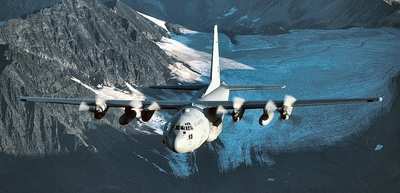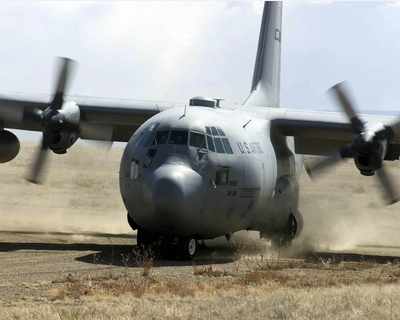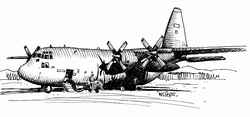C-130s Provide Transport For Varied Passengers
Security forces protect Air Force people and resources
worldwide, even when those resources are on the move at more than
300 miles per hour.

The C-130 Hercules cargo plane is the primary means of moving
supplies and troops around Afghanistan. Aircrews frequently land at
remote, dirt landing strips to support US and coalition forces.
In a combat zone, high-value assets -- like aircraft and people
-- need protection. But these small, out-of-the-way airfields often
have little or no security. The 455th Expeditionary Security Forces
Squadron has a solution to this security dilemma in the form of the
Fly-Away Security Team, or FAST.
 "Our job is to protect
the aircraft and its crew at all forward operating bases throughout
Afghanistan," said Maj. J. Scott Sanford, the squadron's
commander.
"Our job is to protect
the aircraft and its crew at all forward operating bases throughout
Afghanistan," said Maj. J. Scott Sanford, the squadron's
commander.
Similar to the "Phoenix Raven" program in the Air Force's Air
Mobility Command -- which specially trains security forces members
for duty aboard cargo aircraft -- the teams here enable C-130s to
land at airfields throughout the theater, and sometimes countries
outside Afghanistan.
When a Hercules lands at a remote strip, the security forces
pour out from the back of the plane and take up positions where
they can keep an eye on the surrounding landscape.
"We're here to deny unauthorized people access to the plane,"
said Senior Airman Charles Coles, a FAST member deployed here from
Eglin Air Force Base, FL.
Protecting the aircraft on the ground is only part of the job.
C-130 crews often find themselves transporting non-US troops and
civilians, as well as enemy detainees.
"In the air, if there are a lot of foreign nationals or
prisoners, we do 'cockpit denial,'" -- measures taken to prevent
hijacking, Coles said.
The teams also provide security for distinguished visitors,
military and civilian, who sometimes travel aboard the
aircraft.

"You never know what to expect when you get onboard the
aircraft," said Tech. Sgt. Robert Taverna, noncommissioned officer
in charge of the FAST missions. "We have had teams go out to secure
130s with mechanical difficulties stuck overnight at forward
operating bases, and our teams are out there providing security
until parts can be flown to the location."
The aircrews receive peace of mind knowing that security teams
are watching out for them.
"If they're going to tell me to take (a security team) with us,
I'm going to take them with us and be glad we have them," said Maj.
Jim Hornbeck, a C-130 pilot from the Delaware Air National
Guard.
The fly-away missions are a welcome change of pace for the
security forces airmen.
 "I get to leave the
base," said Airman Maurice Grant, part of the FAST program. "After
12-hour shifts every day, I don't get outside the wire. It's a
change of scenery."
"I get to leave the
base," said Airman Maurice Grant, part of the FAST program. "After
12-hour shifts every day, I don't get outside the wire. It's a
change of scenery."
"I'm really proud of the airmen who do these missions," Sanford
said. "For most security forces, this is not something they have
daily experience doing until they get here."
The major said his FAST airmen have flown more than 90,000 miles
in six months, or the equivalent of almost 26 trips between London
and New York, to support the airlift mission in Iraq.
(Aero-News salutes Air Force Maj. David Kurle, 455th Air
Expeditionary Wing public affairs.)
 ANN's Daily Aero-Term (05.02.24): Touchdown Zone Lighting
ANN's Daily Aero-Term (05.02.24): Touchdown Zone Lighting Aero-News: Quote of the Day (05.02.24)
Aero-News: Quote of the Day (05.02.24) Aero-News: Quote of the Day (05.03.24)
Aero-News: Quote of the Day (05.03.24) ANN's Daily Aero-Term (05.03.24): UAS Traffic Management (UTM)
ANN's Daily Aero-Term (05.03.24): UAS Traffic Management (UTM) ANN's Daily Aero-Linx (05.03.24)
ANN's Daily Aero-Linx (05.03.24)






